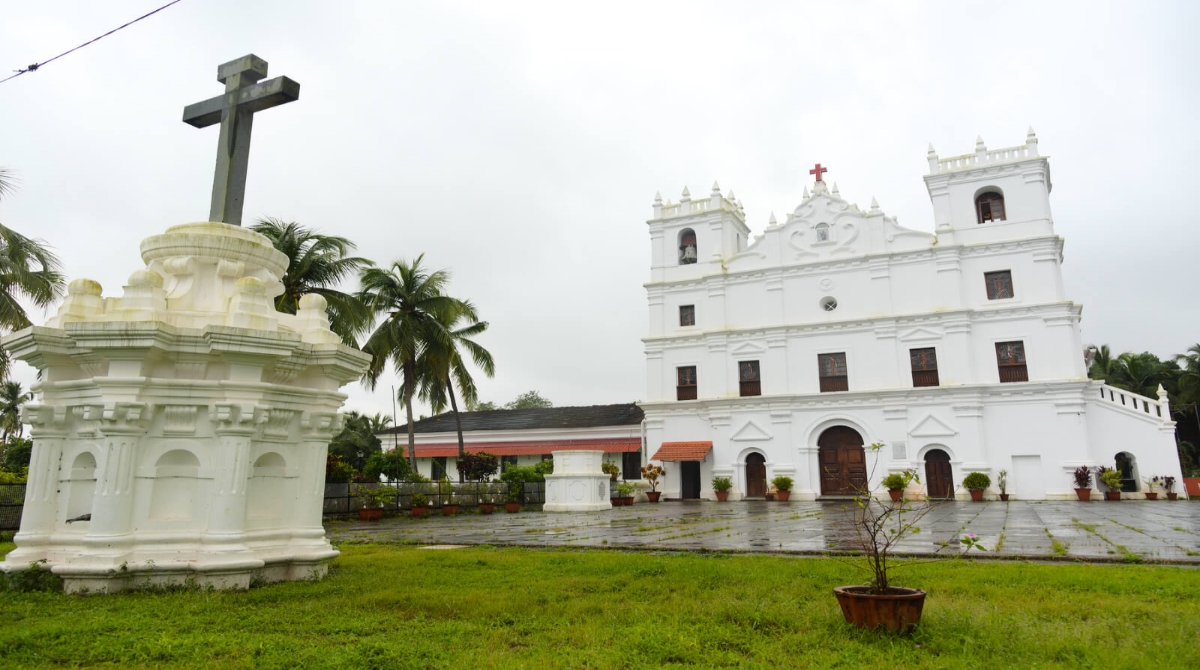St. Thomas church Aldona is located in North Goa, nearly 8 kms from Mapusa. The Aldona church consists of ornately embellished symbolic murals depicting tales from the Bible and additionally with grand statues.
The Feast of St. Thomas is celebrated with pomp and gaiety on the 2nd Saturday following Easter. St. Thomas used to be chosen as the patron since the inception of the parish.
Aldona church is the seventh parish installed through the Franciscans in Bardez. They commenced their ministry in Coimavaddo, the place they constructed the unique church of the village, back in the year 1569.

Church of St. Thomas Religious Significance
Aldona Church is considered as one of the most sacred churches in Goa and is meant for God lovers and people searching for miracles and experiences with God.
This Church is also greatly associated with its history. Despite being a Christian church people of all religions can visit the sacred Sanctorum.
The most important event celebrated in the church is a feast on the third Sunday after Easter. Another event celebrated is the day of Dia Dos Ladroes in June.
Christmas and Easter are the most important festival celebrated. The church is open throughout the year from 8 am till 10 am in the morning. It just requires around an hour to tour the church.
Church of St. Thomas Historical Significance
The building of the church is associated with the establishments of Christian’s churches by Bishops from Persia in 6th century and 10th century. The church of St Thomas was established in 1569 AD at Comiavaddo by Portuguese missionaries.
The Church of St Thomas standing today in Goa is the renovated form of the original church that was built in 1898 AD. The original structure was made up of mud and was formed by the Franciscans. The presiding structure was built in 1610 AD.
Church of St. Thomas Architectural Significance
The Church is a massive white structure built in European Gothic architectural style. The structure comprises of sacristy and a parochial house.
A tower is also present on the left side of the church along with vestibules, pillars and pilasters in the front. The main entrance is accompanied by a huge gate accompanied by smaller others in the western side.
The statue of Saint Thomas resides in the altar of the church in an elevated platform along with seats for higher dignitaries and also for public in front separately for men and women.
The Church consists of grand statues decorated with precious jewels and ornaments. There are a number of chapels with and without chaplains.
A bell is installed in the backyard of the church to signal the timing of rituals, during the death of a member of the church or to inform any bad messages.
CHORANCHEM FEST: THE INCIDENT THAT INCREASED PEOPLES FAITH AND GRATITUDE TOWARDS ST. THOMAS IN THE LATE 1800’s
The people’s reverence and gratitude to St. Thomas reached its peak, on October 29th 1895.
When the peaceful village was once all of sudden became into a minor battlefield, the villagers were aroused at the dead of night time by the blaring of trumpets and conch shells.
A band of robbers had crossed the Corjuem ferry to loot and plunder the church. Having damaged down the main door they entered the scared precincts, and tried in vain to spoil open the iron safe.
They abandoned the attempt and planned to enter the sanctuary but were petrified to find, in accordance to eye witness, an angelic figure with a drawn sword blocking off the entrance.
Meanwhile the villagers having heard the alarm gathered with spades, scythes, bamboos, brooms, sticks to meet the invaders.
On trying to flee they had been pelted with stones in all directions, 16 were killed, 4 had been taken as prisoners and the rest drowned at the while trying to escape. In commemoration of this special event the ‘Choranchem Fest’ or ‘Robbers feast’ is celebrated yearly on 29th October.



